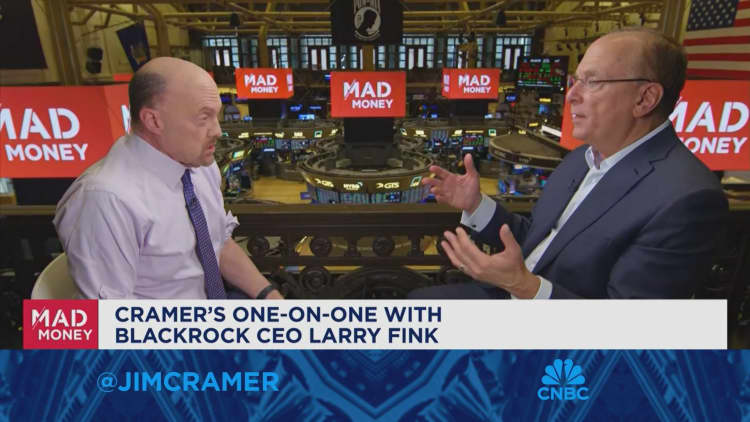BlackRock debuts strategy to provide paycheck-like income in retirement

Patchareeporn Sakoolchai | Moment | Getty Images
BlackRock, the largest asset manager, has launched a new product to help workers their retirement savings into a regular income stream that mimics the paycheck they receive during their working years.
Experts say while the new choice could be helpful, its success will be defined by whether consumers actually take advantage of it.
The BlackRock product, called LifePath Paycheck, aims to make one choice simpler â how to withdraw from lifetime investments â that workers now face after a broad shift from defined benefit plans like pensions to defined contribution plans like 401(k) plans.
“We’re talking about a revolution in retirement,” BlackRock CEO Larry Fink wrote of LifePath Paycheck in his recent annual letter to investors.
The strategy provides guaranteed income through a target-date fund, which typically provide a mix of stocks, bonds and other investments that become more conservative as an investor nears their anticipated retirement age.
More from Personal Finance:
Most retirees don’t delay Social Security benefits
Women reaching ‘peak 65’ more likely to struggle in retirement
Americans think they need almost $1.5 million to retire
Employees who opt in to LifePath Paycheck through their employer-provided retirement plan will start making allocations to lifetime income starting at age 55. Then, starting at age 59½ and up until the year they turn 72, they may start regular withdrawals from that sum.
While they receive that income, the rest of their retirement savings may continue to grow.
A recent BlackRock survey found 60% of employees worry they may outlive their retirement savings.
Other research from the Transamerica Center for Retirement Studies has similarly found the greatest retirement fear for workers 50 and up is running out of their savings and investments.
Around 500,000 employees now have access to the strategy through 14 retirement plan sponsors, according to BlackRock.
For now, the LifePath product is limited to plans offered through employers. But BlackRock would eventually love to make a similar option available through funds for individuals who do not have access to employer plans, Anne Ackerley, head of retirement at BlackRock, said during a Wednesday presentation in New York.

While the development may start in the U.S. first, Fink predicted in his annual letter that it will likely spread to other countries.
“I believe it will one day be the most used investment strategy in defined contribution plans,” Fink wrote.
Investor utilization key to success
Experts say much of the strategy’s success will depend on whether employees opt in.
For sustainable energy company Avangrid, implementing LifePath Paycheck has provided a way to smooth its recent transition from a defined benefit to defined contribution plan, said Paul Visconti, senior director of total health and retirement programs at the company.
“Adding this feature to it really … gives some of the legacy employees some of that comfort they have from the legacy pension plan,” Visconti said.
The company hopes the benefit feature will help attract and retain employees in a competitive industry, he said. However, because it just went live at Avangrid on Monday, the company does not yet have data on how many employees age 55 and older may have signed up. However, the company has been actively educating its 8,000 employees on the offering.
Annuity options in retirement plans will likely become as widely embraced as target-date funds are today, predicts Jason Fichtner, chief economist at the Bipartisan Policy Center and executive director at the Alliance for Lifetime Income’s Retirement Income Institute.
Annuity income helps retirees understand how much they can spend, while also letting them better absorb risks in other areas of their investment portfolio, he said.
Moreover, having income through an annuity may help worker create an income bridge that enables them to delay claiming Social Security retirement benefits, according to joint research from the Bipartisan Policy Center and BlackRock published last year.
Social Security benefits are a “life annuity” that increases annually with inflation, “a rare feature on the private market,” the research notes. Moreover, for every year a retiree delays benefits from their full retirement age â typically 66 or 67 â up to age 70, they get an 8% increase, a guaranteed return that is also hard to match elsewhere.
Social Security is “unequivocally” the first place people should look to make the most of their retirement income, said David Blanchett, managing director and head of retirement research at PGIM DC Solutions.
“Will it help people to buy this product? It would likely help them to delay claiming Social Security more,” Blanchett said.
While there have been other products offering lifetime income available in the defined contribution market for over a decade, it’s up to individuals to actively convert their savings to lifetime income. And few participants tend to take that step, he said.
“Very few people who end up in this product actually receive any kind of paycheck, because they don’t always know what they’re signing up for,” Blanchett said.
While many people like the idea of guaranteed fixed income, they often don’t seek products on their own that will provide that income stream from their retirement plan savings once they retire, said Dan Doonan, executive director at the National Institute on Retirement Security, a non-profit research and education organization.
The annuity choices consumers face on their own are “incredibly complex,” with regard to who to buy from and assessing whether they’re getting a good deal, Doonan said. Having an employer plan provide these options can help remove those uncertainties and may result in higher utilization, he predicts.
“People are much more likely to do these things when they’re part of the plan they have at the office at work,” Doonan said.
BlackRock’s move will likely push other groups to enhance their retirement plan annuity options, Doonan predicts. “It might look very different in 10 years,” he said.




